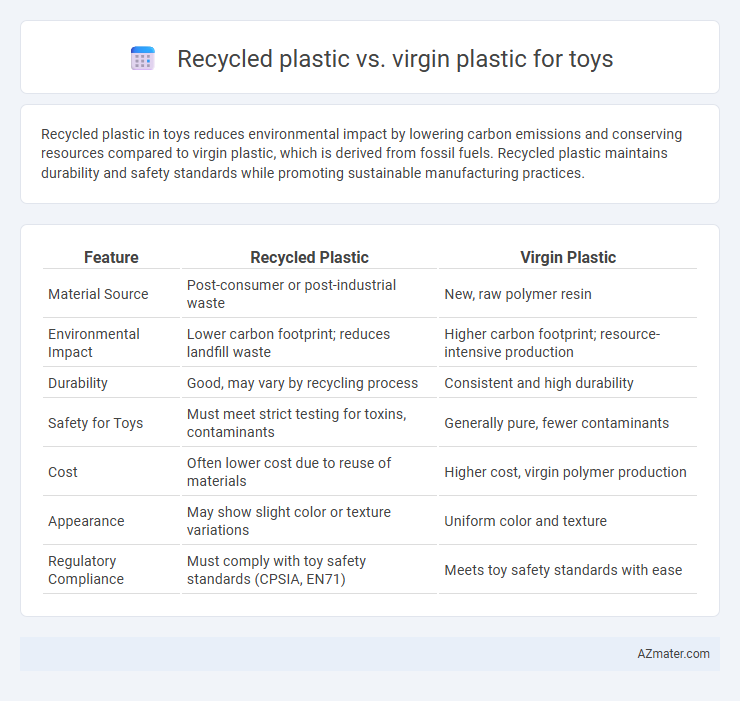Recycled plastic in toys reduces environmental impact by lowering carbon emissions and conserving resources compared to virgin plastic, which is derived from fossil fuels. Recycled plastic maintains durability and safety standards while promoting sustainable manufacturing practices.
Table of Comparison
| Feature | Recycled Plastic | Virgin Plastic |
|---|---|---|
| Material Source | Post-consumer or post-industrial waste | New, raw polymer resin |
| Environmental Impact | Lower carbon footprint; reduces landfill waste | Higher carbon footprint; resource-intensive production |
| Durability | Good, may vary by recycling process | Consistent and high durability |
| Safety for Toys | Must meet strict testing for toxins, contaminants | Generally pure, fewer contaminants |
| Cost | Often lower cost due to reuse of materials | Higher cost, virgin polymer production |
| Appearance | May show slight color or texture variations | Uniform color and texture |
| Regulatory Compliance | Must comply with toy safety standards (CPSIA, EN71) | Meets toy safety standards with ease |
Introduction to Recycled and Virgin Plastics in Toys
Recycled plastic in toys is derived from processed post-consumer or post-industrial plastic waste, offering an eco-friendly alternative that reduces landfill waste and conserves natural resources. Virgin plastic, produced directly from petrochemicals, provides consistent quality, durability, and safety, which are critical for children's products. Choosing between recycled and virgin plastics impacts environmental footprint, manufacturing costs, and regulatory compliance in toy production.
Environmental Impact: Recycled vs Virgin Plastic
Recycled plastic significantly reduces environmental impact compared to virgin plastic by lowering carbon emissions and conserving natural resources such as petroleum. Manufacturing toys from recycled plastics typically consumes less energy and generates less landfill waste, contributing to a smaller ecological footprint. Virgin plastic production involves extensive extraction and processing activities that increase pollution and greenhouse gas emissions, making recycled plastic the more sustainable choice for toy manufacturing.
Safety Standards for Toy Materials
Recycled plastic used in toys must meet strict safety standards such as ASTM F963 and EN71, ensuring absence of harmful chemicals and contaminants. Virgin plastic offers consistent purity and predictable composition, reducing risks of toxic leachates or structural weaknesses. Both materials undergo rigorous testing for heavy metals, phthalates, and mechanical hazards to guarantee child-safe toy production.
Cost Comparison: Production and Pricing
Recycled plastic for toy production often reduces raw material costs by up to 30% compared to virgin plastic, primarily due to lower sourcing expenses and decreased energy requirements during manufacturing. Virgin plastic, while more expensive--sometimes as much as 50% higher in cost--offers consistent quality and fewer impurities, which can minimize production defects and rework. Pricing strategies for toys using recycled materials can leverage eco-friendly appeal to justify competitive retail pricing despite slight variations in production efficiency.
Durability and Quality Differences
Recycled plastic in toys often shows slight compromises in durability compared to virgin plastic due to potential degradation of polymer chains during the recycling process. Virgin plastic provides superior structural integrity and consistent quality, resulting in longer-lasting, more resilient toys that withstand repeated use. However, advanced recycling technologies are improving the quality of recycled plastic, narrowing the gap in durability and performance for toy manufacturing.
Consumer Perceptions and Preferences
Consumers increasingly prefer recycled plastic toys due to growing environmental awareness and sustainability concerns, associating them with eco-friendly practices. Perceptions of durability and safety remain critical, with many buyers hesitant about recycled plastic's quality compared to virgin plastic, which is often seen as more reliable and pure. Market trends reveal a rising demand for transparent sourcing and certification to assure recycled materials meet stringent safety standards for children's products.
Regulatory Requirements and Certifications
Recycled plastic used in toys must comply with strict regulatory requirements such as the US Consumer Product Safety Improvement Act (CPSIA) and the European REACH regulation, ensuring no harmful substances exceed safe limits. Virgin plastic often benefits from well-established certifications like FDA food-grade approval and ISO 9001 quality management, guaranteeing purity and consistent manufacturing standards. Both recycled and virgin plastics require adherence to standards like ASTM F963 and EN 71 to verify safety, but recycled materials must undergo additional testing for contaminants and heavy metals to meet these certifications.
Innovations in Recycled Plastic Technologies
Innovations in recycled plastic technologies have significantly enhanced the quality and safety of recycled plastics used in toy manufacturing, enabling them to match or exceed the durability and non-toxicity of virgin plastics. Advanced chemical recycling and improved sorting methods allow for higher purity and consistency in recycled polymers, reducing contamination and extending the material's lifecycle in children's products. These technologies support sustainability efforts by lowering carbon footprints and promoting circular economies within the toy industry.
Brand Case Studies: Sustainable Toy Manufacturers
Sustainable toy manufacturers such as Green Toys and PlanToys highlight the advantages of recycled plastic by reducing environmental impact and promoting circular economy principles. These brands demonstrate that recycled plastic maintains safety and durability standards essential for children's products, contrasting with virgin plastic's higher carbon footprint. Case studies reveal that integrating recycled materials not only enhances brand reputation but also drives consumer preference for eco-friendly toys.
Future Trends in Toy Material Sustainability
Recycled plastic in toy manufacturing is gaining momentum due to growing environmental regulations and consumer demand for eco-friendly products, offering reduced carbon footprints compared to virgin plastic. Advances in recycling technologies are improving the quality and safety of recycled plastics, enabling broader application in durable and non-toxic toy components. Future trends indicate an increasing shift towards hybrid materials and bio-based alternatives, with manufacturers prioritizing circular economy principles to enhance sustainability in toy production.

Infographic: Recycled plastic vs Virgin plastic for Toy
 azmater.com
azmater.com